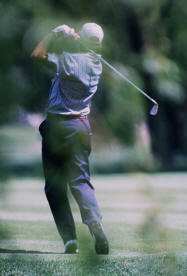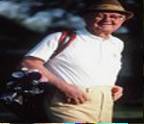Jack Long . . . Facts, Fiction, Hope
The Phenomenon Of The Short-Putt-After-The-Missed-Putt
The professional faces a chip shot, sixty feet away from the pin. The player chooses a club, swings and the ball stops fourteen inches from the hole.
On the green, the player (a) examines the lie of the ball from two or three different angles
(b) walks up to the ball, examines it at close range, and then steps slightly away from the ball,
(c) takes two or three practice strokes,
(d) addresses the ball and assumes a nearly-unvarying stance,
(e) takes an unvarying grip on the putter,
(f) wriggles the putter over the ball,
(g) conjures some sort of putt-think,
(h) orients toward the hole or along a trajectory determined by green speed, break, etc.,
(i) focuses on the mechanics of the stroke while at the same time, trying to both relinquish and assume control,
(j) looks intently at the target and then back at the ball, and
(k) without delay, takes the stroke.
The ball rims the cup and is launched away from the hole, stopping at a seven-inch remove.
A deep breath is followed by a seemingly careless approach to the short-putt-after-the-missed-putt.
The player (a) steps up to the ball (no careful look at the lie and no practice strokes),
(b) leans forward on the ball of one foot with his torso, arms, non-leaning leg, and head at angles and in planes which do not replicate the angles and planes of the “nearly-unvarying” putt-stance.
and (c) takes the stroke and makes the putt. The player is focused almost exclusively on the fact that he missed the easy fourteen-inch putt.
That focus manifests itself as either one of, or a combination of two primal emotions:
· Annoyance, the extent of which is related to the speed and angle of the ball on the rim-out; and
· Amusement, the extent of which is directly proportional to the depth of the player’s understanding of
Heisenberg’s Uncertainty Principle (“HUP”) which, when applied to this series of events, informs the player of the inability to accurately predict the moment-to-moment behavior of the ball while it is on its trajectory toward the cup.
Players who appreciate the operation of the HUP will experience amusement, while those who are largely ignorant of it will be annoyed.
As an aside, any golfer who wants to experience “centeredness” must have a working understanding of the HUP.
Such an understanding is the only effective neutralizer of the negative cosmic forces which combine to create...
Playing Under Pressure (“PUP”).
One might think that for an experienced player, the difference in the degree of difficulty between a fourteen-inch putt and a seven-inch putt ought to be relatively small, even if the lie of each putt is somewhat different.
However, there is a significant difference in that for the second putt, the player subconsciously substituted a perceived inevitability of success and the cathartic primal emotions of annoyance and/or amusement, for the rituals, hope, logic, superstitions, prayers and fear associated with the missed fourteen-inch putt.
What does the foregoing have to do with improving your putting game?
Most readers are qualified to write their own conclusions as to how these observations and insights can be used not only to untangle the innate sense of putting (“ISP”), but also to restore confidence in the ability acquired as a toddler to initially project a Continuous Trajectory.
These and many other topics will be addressed in future articles.
No part of this article may be used or reproduced in any manner whatsoever without written permission from Jack Long, PGI, 192 College Street, Burlington, VT 05401.
The other articles in the series can be found by clicking the links below.
Jack Long
Jack Long3
Jack Long4
Jack Long5
Jack Long6
Jack Long7
Jack Long8
Jack Long9
Jack Long10
Jack Long11
Jack Long12
Jack Long13





